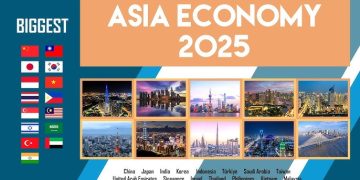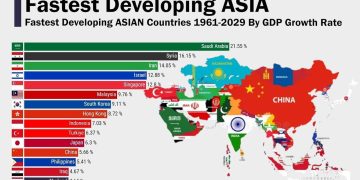1. Introduction: The Quiet Revolution in Asia’s Debt Markets
Beneath the headlines of equity rallies and tech innovation, a quieter but no less significant financial transformation is unfolding across Asia: the rise and restructuring of its bond markets.
As 2025 advances, policymakers, investors, and corporate treasurers from Tokyo to Jakarta are navigating a new debt environment — one defined by higher global interest rates, currency diversification, and shifting investor appetite.
Gone are the days when Asian bonds were seen as peripheral or high-risk assets tethered to U.S. monetary policy. Today, the region is emerging as a laboratory for sovereign debt innovation, from China’s dim sum and panda bonds to ASEAN’s burgeoning local-currency green debt initiatives.
But this transition is not seamless. Behind the surge in issuance lies a web of structural challenges: rising fiscal deficits, volatile currencies, and uneven regulatory integration. The question in late 2025 is not whether Asia’s bond markets will grow — they already have — but whether they can mature fast enough to anchor the region’s next phase of economic resilience.
2. The Global Context: Debt in an Era of Tight Liquidity
The shift in Asia’s bond landscape cannot be understood without the global backdrop.
After years of near-zero interest rates, the global cost of capital has risen sharply. The U.S. Federal Reserve’s cautious but persistent tightening cycle — keeping rates above 4% through mid-2025 — has redrawn yield curves worldwide.
In Europe, fiscal pressures linked to energy transition costs and social spending have driven public debt ratios to record highs. Meanwhile, global debt as a share of GDP reached 333% in early 2025 (according to the Institute of International Finance), underscoring the systemic vulnerability to rate shocks.
For Asia, this new reality presents both risk and opportunity.
Risk, because higher rates amplify debt-servicing costs for governments and corporates.
Opportunity, because investors hunting for yield are rediscovering Asia’s relatively healthier balance sheets, demographic tailwinds, and currency diversification potential.
In short: the liquidity tide is lower, but Asia’s vessels are sturdier than many expected.
3. The Rise of Local Currency Debt
Perhaps the most transformative shift in Asia’s debt structure is the growing dominance of local currency bonds.
A generation ago, much of Asia’s external borrowing was dollar-denominated — a vulnerability exposed during the 1997 Asian Financial Crisis. Since then, the region has made deliberate efforts to develop deep, liquid domestic bond markets.
By 2025, local-currency debt accounts for roughly 85% of total outstanding bonds in major Asian economies, up from less than 60% in 2005.
The motivations are clear:
- Currency stability: Borrowing in domestic currency insulates sovereigns and corporates from exchange rate volatility.
- Policy flexibility: Local bond markets allow governments to fund deficits without heavy reliance on foreign capital.
- Investor confidence: The development of benchmark yield curves fosters pricing transparency and secondary market depth.
China’s onshore bond market, now exceeding $20 trillion, is the world’s second largest, trailing only the U.S. Japan’s government bond (JGB) market remains a global anchor of liquidity, while South Korea and India continue to expand their corporate bond issuance to finance infrastructure and energy transition projects.
Even smaller economies like Vietnam, Indonesia, and the Philippines have broadened local participation. Domestic pension funds and insurers now absorb a significant portion of sovereign debt, reducing dependence on volatile foreign inflows.
This evolution — from foreign currency fragility to local resilience — represents perhaps Asia’s most underappreciated post-crisis achievement.
4. The Renminbi’s Expanding Role
No discussion of Asia’s debt architecture is complete without the Renminbi (RMB) — both as a funding currency and as a symbol of regional financial autonomy.
In 2025, RMB-denominated bond issuance — including dim sum bonds in Hong Kong and panda bonds in mainland China — is experiencing renewed vigor.
Dim sum bond volumes rose 38% year-on-year in the first half of 2025, reaching their highest levels since 2018. Meanwhile, foreign issuers from Europe, the Middle East, and ASEAN are increasingly tapping the panda bond market to access Chinese investors directly.
This reflects both geoeconomic pragmatism and monetary diversification.
As sanctions risk and U.S. fiscal uncertainty grow, global borrowers are eager to hold part of their liabilities in currencies outside the dollar system. The RMB offers a middle ground: credible, liquid, and increasingly integrated into cross-border settlement systems such as CIPS (Cross-Border Interbank Payment System).
At the policy level, Beijing is carefully balancing capital account openness with systemic control. The People’s Bank of China continues to liberalize access for qualified institutional investors while maintaining macroprudential levers to manage outflows.
The result: a slow but steady internationalization of the RMB bond ecosystem, anchored in regional trust rather than speculative flows.

5. The Green Bond Boom
If local-currency markets represent Asia’s financial foundation, green and sustainable bonds are its new frontier.
Across Asia, governments and corporations are leveraging capital markets to fund renewable energy, sustainable infrastructure, and climate adaptation projects.
According to the Climate Bonds Initiative, Asia-Pacific accounted for over 45% of global green bond issuance in 2024 — a figure expected to rise further in 2025.
China remains the largest single issuer, followed by Japan, South Korea, and Singapore.
But the growth story extends well beyond the region’s giants.
Vietnam and Indonesia have launched sovereign green bond frameworks aligned with the EU taxonomy, while India’s “sovereign green bond” program, initiated in 2023, has become a model for balancing environmental credibility with investor returns.
Notably, ASEAN+3 (including China, Japan, and South Korea) is developing a common regional green bond standard, aimed at harmonizing disclosure and verification requirements. If implemented effectively, this could create one of the world’s largest and most liquid pools of sustainable debt — a true “Green Asia Yield Curve.”
6. Foreign Participation and Financial Integration
Despite these advances, foreign participation in Asian bond markets remains uneven.
While foreign investors hold around 15% of local government bonds in Malaysia and 20% in Indonesia, the figure is below 5% in China’s onshore market, largely due to lingering concerns over convertibility, transparency, and repatriation.
However, gradual integration mechanisms are improving access.
The Bond Connect program linking Hong Kong and mainland China continues to grow, with daily average turnover surpassing US$30 billion in early 2025.
In parallel, ASEAN’s Capital Markets Forum is piloting cross-border settlement protocols to facilitate regional bond ETF trading — a small but significant step toward a pan-Asian capital market.
Financial integration is not only a question of market plumbing but also trust and policy alignment.
As geopolitical uncertainty persists, Asia’s ability to maintain open, rules-based financial cooperation will be crucial to sustaining investor confidence.
7. Challenges: Debt, Demographics, and Discipline
Asia’s bond boom is not without its vulnerabilities.
Several structural headwinds loom large:
- Public debt accumulation: Post-pandemic fiscal expansion has left many Asian economies with debt-to-GDP ratios above 70%, constraining policy flexibility.
- Demographic pressures: Aging populations in Japan, South Korea, and China will increase pension liabilities, pushing long-term yields upward.
- Corporate leverage: Non-financial corporate debt in China and South Korea remains elevated, raising concerns about refinancing risk in a higher-rate environment.
- Market depth and transparency: Despite progress, liquidity remains concentrated in sovereign paper, with corporate bond secondary markets still shallow in most of ASEAN.
In essence, Asia’s debt markets are expanding faster than their regulatory and institutional capacity — a mismatch that could test resilience if global shocks intensify.
8. Outlook: Toward a Multipolar Bond Ecosystem
Looking ahead, Asia’s bond markets are poised to play a central role in the rebalancing of global finance.
Several trajectories are already visible:
- The RMB will continue to gain traction as a settlement and funding currency within Asia.
- Local currency debt will deepen as pension and insurance reforms mobilize domestic savings.
- Green and digital bonds will attract a new generation of ESG-focused investors.
- Regional coordination under platforms like ASEAN+3 and RCEP will reduce fragmentation and enhance market interoperability.
If the 1990s defined Asia’s bond markets by fragility and the 2010s by recovery, the 2020s may define them by maturity.
The challenge now is governance: ensuring that rapid expansion is matched by risk discipline, transparency, and policy consistency.
As one Tokyo-based strategist observed, “Asia’s bond markets no longer mirror the West — they mirror Asia’s own ambitions.”
And in 2025, those ambitions are finally finding their yield curve.
































